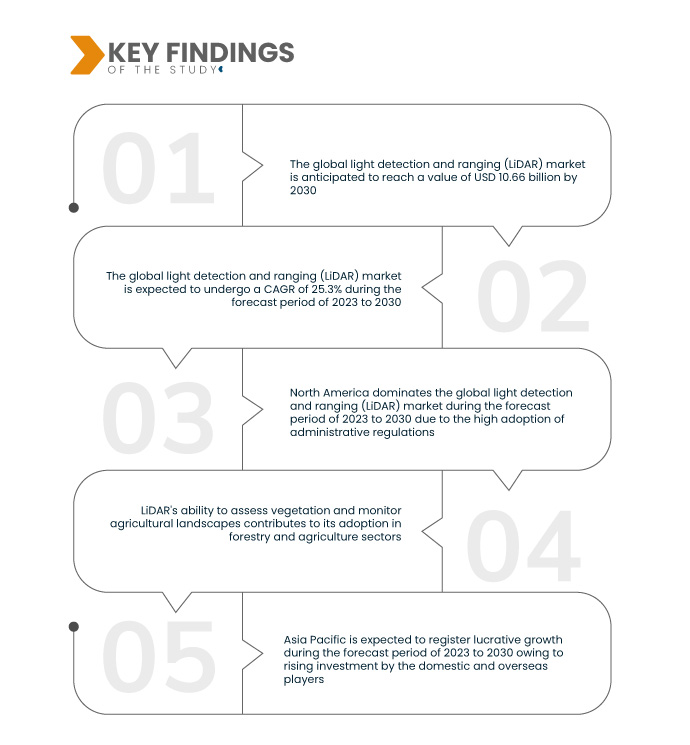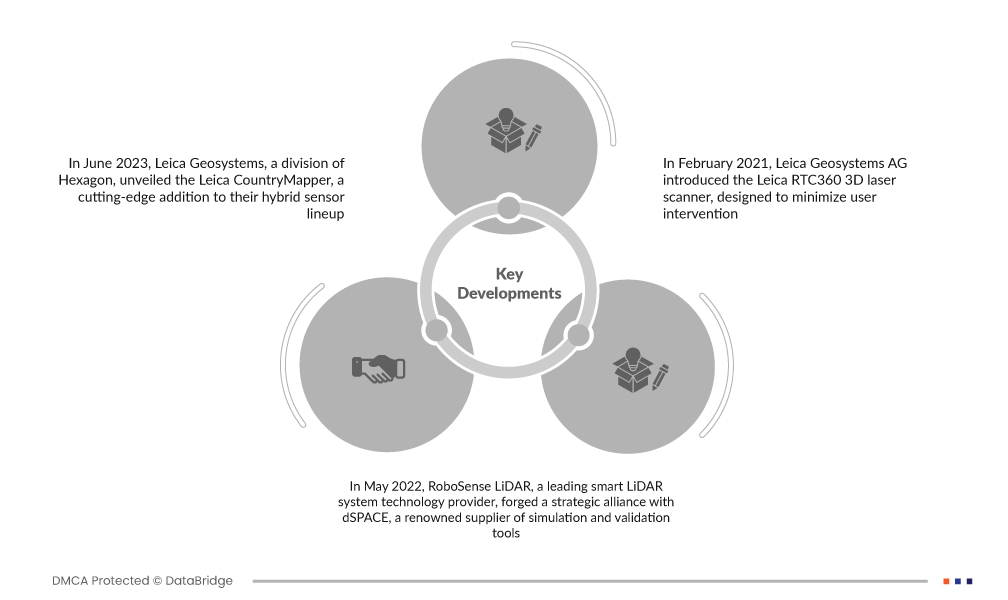LiDAR (Light Detection and Ranging) is a remote sensing technology that utilizes laser light to measure distances and create high-resolution 3D models of the Earth's surface. It operates by emitting laser pulses and recording the time it takes for the pulses to return after hitting an object or surface. This data allows for precise mapping of terrain, vegetation, and infrastructure, and is especially useful in areas that are difficult to access, such as dense forests or rugged landscapes. LiDAR has a wide range of applications, including environmental monitoring, topographic surveys, archaeology, and forestry. It offers advantages over traditional surveying methods by providing more accurate, detailed, and comprehensive data in a shorter time frame. Additionally, LiDAR systems can operate from the air (using drones or aircraft) or from the ground, depending on the specific needs of the project.
Access Full Report @ https://www.databridgemarketresearch.com/pt/reports/global-lidar-market
Data Bridge Market Research analyzes that Global LiDAR Market is expected to reach USD 17.60 billion by 2032 from USD 3.83 billion in 2024, growing with a substantial CAGR of 21.0% in the forecast period of 2025 to 2032.
Key Findings of the Study
Continuous Innovations and Advancements in Lidar Technology
Continuous innovations and advancements in LiDAR (Light Detection and Ranging) technology are driving the rapid growth and expansion of its applications across various industries. LiDAR, which uses laser pulses to measure distances and generate high-resolution 3D maps, has evolved significantly in recent years. These advancements are primarily focused on improving the accuracy, range, speed, and cost-efficiency of LiDAR systems.
One key area of innovation is the development of more compact and lightweight LiDAR sensors. Traditional LiDAR systems were often bulky and expensive, making them suitable only for specific high-end applications. However, recent advances in sensor miniaturization have led to more affordable and versatile systems, making LiDAR technology accessible for a broader range of applications, including use in drones, autonomous vehicles, and mobile mapping systems.
Furthermore, the rise of solid-state LiDAR technology is a game changer. Unlike traditional rotating LiDAR sensors, solid-state LiDARs use fewer moving parts, making them more durable, reliable, and cheaper to manufacture. This innovation is particularly important in industries such as automotive, where low-cost, reliable LiDAR is essential for the widespread adoption of autonomous vehicles.
Report Scope and Market Segmentation
|
Report Metric
|
Details
|
|
Forecast Period
|
2025 to 2032
|
|
Base Year
|
2024
|
|
Historic Years
|
2018-2023 (Customizable 2013-2017)
|
|
Quantitative Units
|
Revenue in USD Billion
|
|
Segments Covered
|
Type (Fixed LiDAR and Rotating LiDAR), Application (Autonomous Vehicles, Aerial Inspection, Robotics, Survey and Mapping, Forestry and Land Management, Renewable Energy, and Others)
|
|
Countries Covered
|
U.S., Canada, Mexico, China, Japan, South Korea, India, Thailand, Malaysia, Indonesia, Vietnam, Taiwan, Philippines, Singapore, Australia, Rest of Asia-Pacific. Germany, France, U.K., Italy, Spain, Russia, Turkey, Netherlands, Belgium, Sweden, Poland, Switzerland, Rest of Europe. Brazil, Argentina, Rest of South America. Saudi Arabia, U.A.E, South Africa, Egypt, Israel, Rest of Middle East and Africa
|
|
Market Players Covered
|
Innoviz Technologies Ltd. (Israel), SICK AG (Germany), Hesai Group (U.S.), Quanergy Solutions, Inc. (U.S.), Cepton, Inc. (U.S.), Génération Robots (France), Teledyne Geospatial (Canada), Aeva Inc. (U.S.), AEye, Inc. (U.S.), and Trimble Inc. (U.S.)
|
|
Data Points Covered in the Report
|
In addition to the insights on market scenarios such as market value, growth rate, segmentation, geographical coverage, and major players, the market reports curated by the Data Bridge Market Research also include in-depth expert analysis, geographically represented company-wise production and capacity, network layouts of distributors and partners, detailed and updated price trend analysis and deficit analysis of supply chain and demand.
|
Segment Analysis
The global LiDAR market is segmented into two notable segments based on by type and application.
- On the basis of type, the market is segmented into fixed LiDAR and rotating LiDAR
In 2025, the fixed LiDAR is expected to dominate the global LiDAR market
In 2025, the fixed LiDAR is expected to dominate the market with the market share of 73.59% due to their stability, high accuracy, and ability to cover large areas
- On the basis of application, the market is segmented into autonomous vehicles, aerial inspection, robotics, survey and mapping, forestry and land management, renewable energy, and others
In 2025, the autonomous vehicles segment is expected to dominate the global LiDAR market
In 2025, the autonomous vehicles segment is expected to dominate the market with the market share of 34.83% due to their reliance on accurate, real-time sensing for navigation and obstacle detection.
Major Players
Data Bridge Market Research Analyzes SICK AG (Germany), Hesai Group (U.S.), Teledyne Optech (Canada), Trimble Inc. (U.S.), and Cepton, Inc. (U.S.) as the major players operating in the market.
Market Developments
- In June 2021, Teledyne Optech and Teledyne CARIS, both Teledyne Technologies companies, have announced the launch of the next-generation bathymetric lidar, the CZMIL SuperNova. This innovative system offers unmatched depth performance and the highest green laser point density in its class, featuring SmartSpacing technology for efficient point distribution, real-time processing to reduce post-processing time, and configurable modes tailored for various water environments
- In November 2024, Trimble announced the winners of its annual Construction Innovation Awards, recognizing North American customers for exceptional use of Trimble technology in areas like design, 3D modeling, estimating, machine control, and construction management. Seven winners were selected at the Trimble Dimensions conference
- In October 2024, Hesai Technology has been named the exclusive LiDAR provider for Leapmotor's next-generation vehicle platform. This partnership will enhance Leapmotor's autonomous driving capabilities with Hesai’s advanced LiDAR solutions. The collaboration aims to accelerate the development of fully autonomous vehicles by integrating high-performance sensing technology for improved safety and navigation
- In November 2023, Aeva secured a production win with Nikon Corporation to supply its micron-precise LiDAR-on-Chip technology for Nikon's industrial metrology and quality control products. The multi-year agreement will integrate Aeva’s technology into Nikon’s automated inspection solutions for automotive, aerospace, and renewable energy sectors, with production starting in late 2024 and product availability in 2025
- In August 2023, AEye, inc. has launched 4Sight+, a software upgrade for its LiDAR platform designed to enhance ADAS and autonomous vehicle systems. The upgrade boosts sensor range by 20% and spatial resolution by 400%, enabling better detection of small objects and vulnerable road users at high speeds. Partners like Continental AG can integrate 4Sight+ to improve highway path planning and manage hazardous situations, such as sudden vehicle cut-ins, with higher precision and confidence
Regional Analysis
The global LiDAR market is categorized across the major countries across U.S., Canada, Mexico, China, Japan, South Korea, India, Thailand, Malaysia, Indonesia, Vietnam, Taiwan, Philippines, Singapore, Australia, rest of Asia-Pacific. Germany, France, U.K., Italy, Spain, Russia, Turkey, Netherlands, Belgium, Sweden, Poland, Switzerland, rest of Europe. Brazil, Argentina, Rest of South America. Saudi Arabia, U.A.E, South Africa, Egypt, Israel, rest of Middle East and Africa.
As per Data Bridge Market Research analysis:
North America is the dominant region in global LiDAR market
North America is expected to dominate the market due to high R&D expenditure on LiDAR technology. In addition, high demand for autonomous vehicles in the U.S. is a major factor driving the market growth in the region.
Asia-Pacific is estimated to be the fastest-growing region in global LiDAR market
Asia-Pacific leads growth in the global LiDAR market due to rapid LiDAR production in China. In addition, countries such as Japan, and South Korea are major producers of autonomies, which eventually have a positive impact on the market growth.
For more detailed information about Global LiDAR Market report, click here – https://www.databridgemarketresearch.com/pt/reports/global-lidar-market














